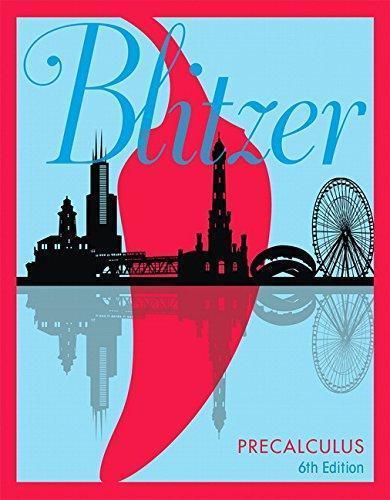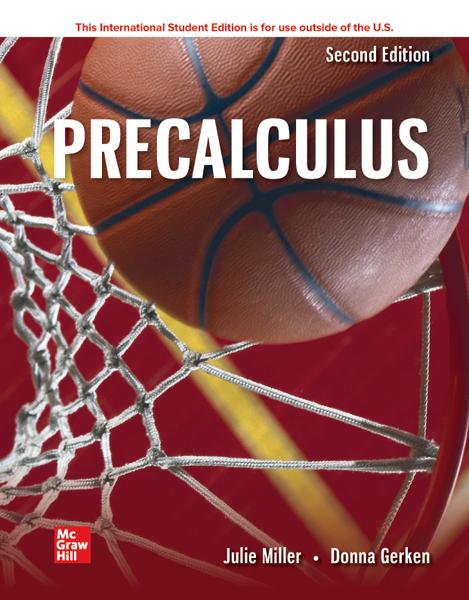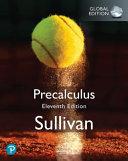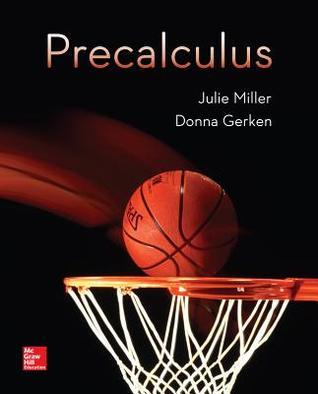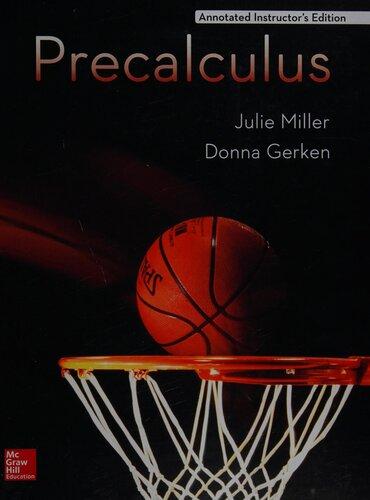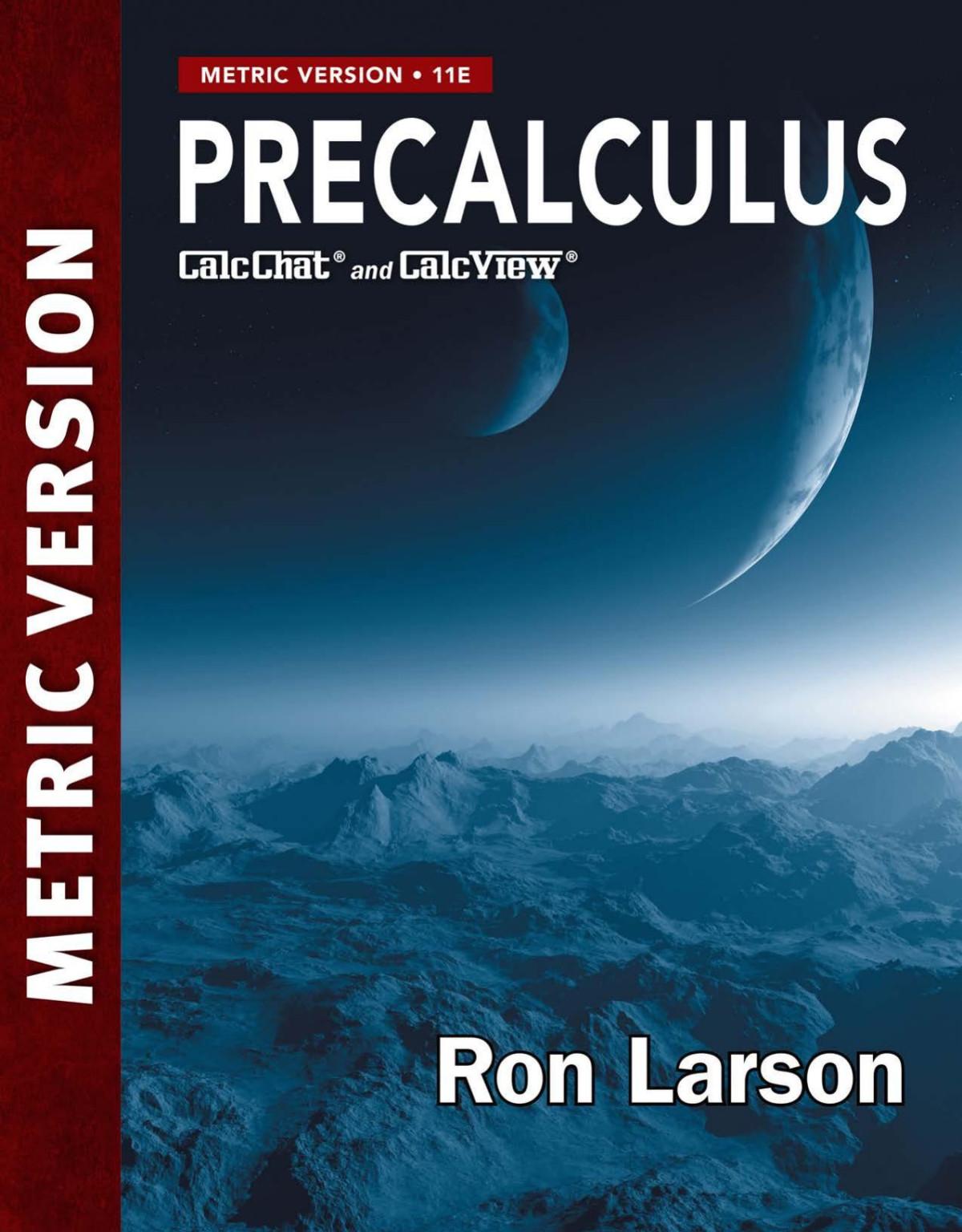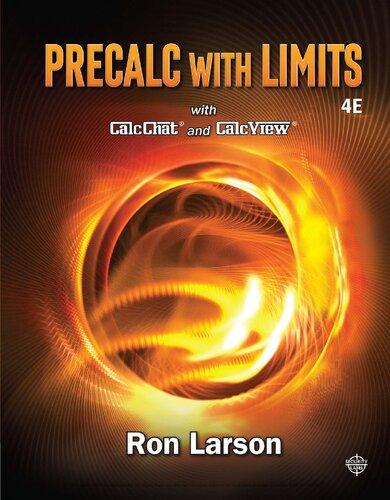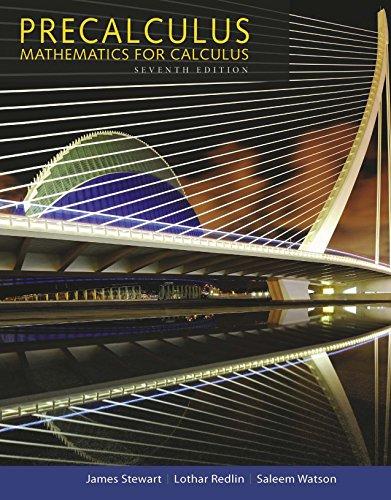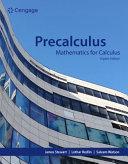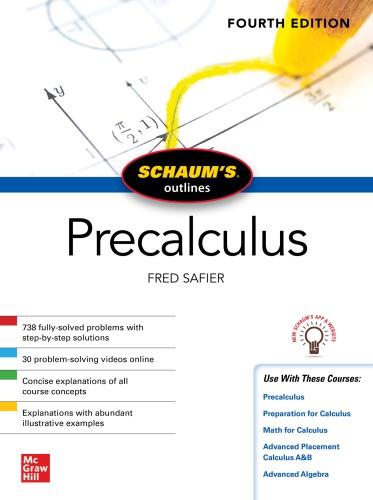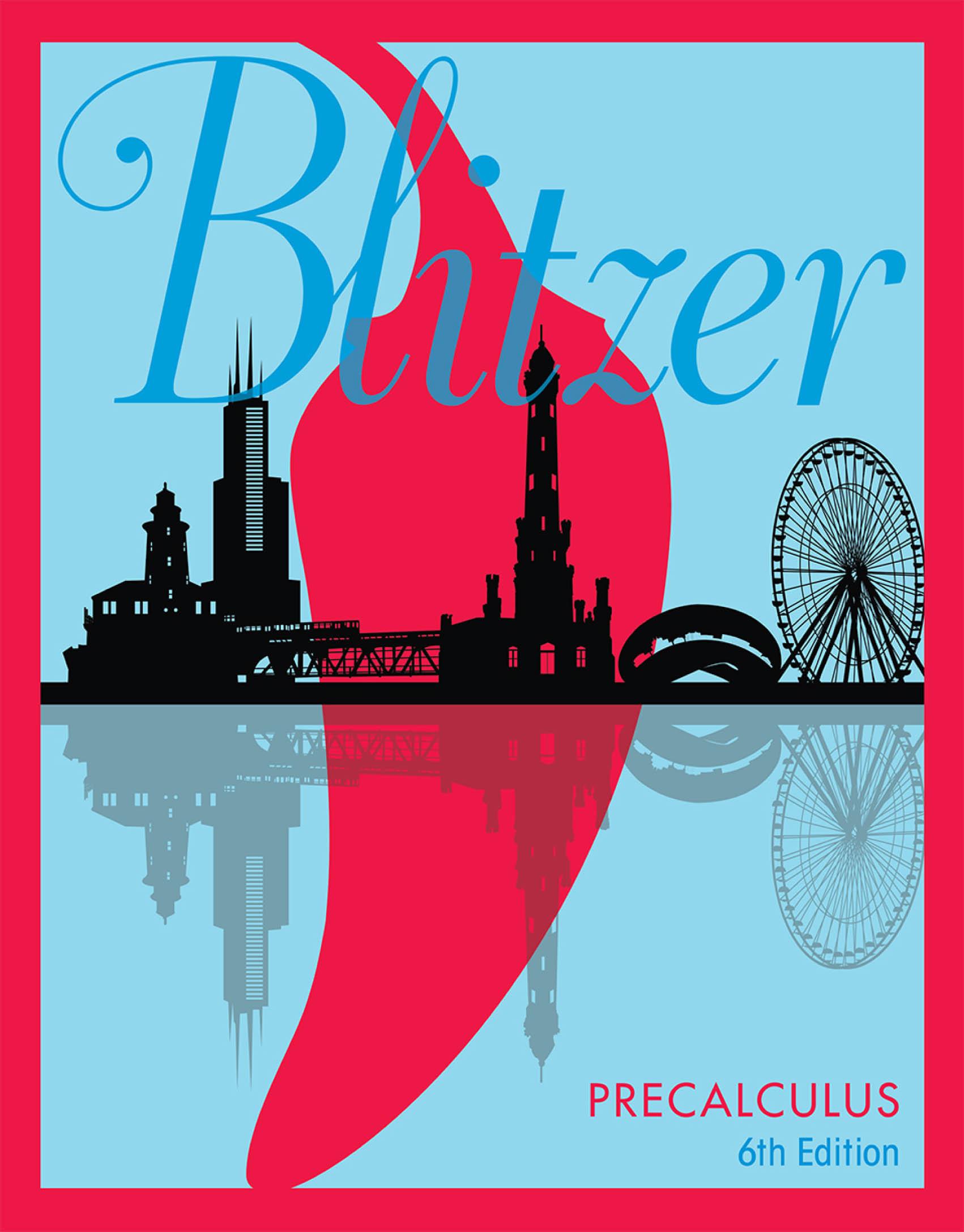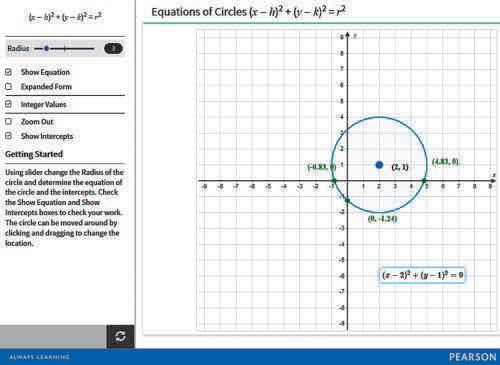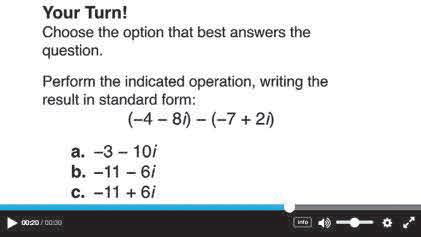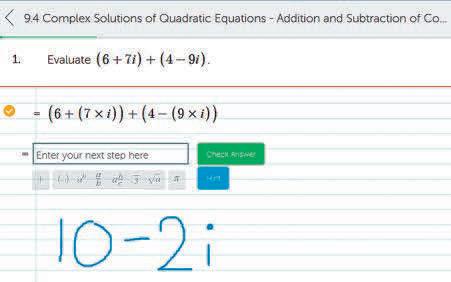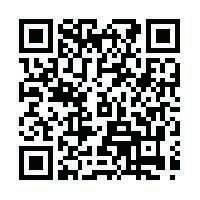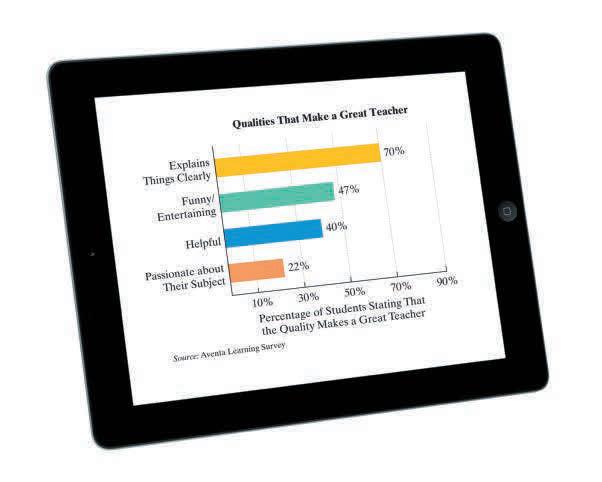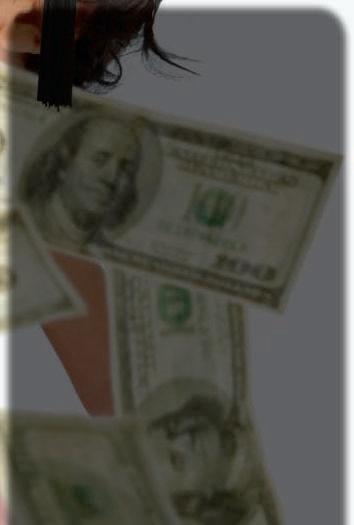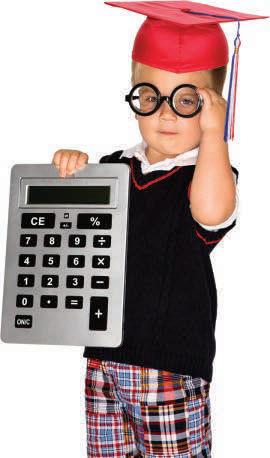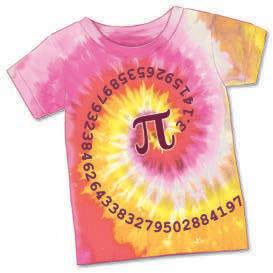PREFACE
• Precalculus develops trigonometry from the perspective of the unit circle (4.2: Trigonometric Functions: The Unit Circle). In Algebra and Trigonometry, trigonometry is developed using right triangles.
• Precalculus contains a chapter (Chapter 11: Introduction to Calculus) that takes the student into calculus with discussions of limits, continuity, and derivatives. This chapter is not included in Algebra and Trigonometry
• Many of the liberal arts applications in Algebra and Trigonometry are replaced by more scienti c or higher level applications in Precalculus. Some examples:
• Black Holes in Space (P.2: Exponents and Scientific Notation)
• Average Velocity (1.5: More on Slope)
• Newton’s Law of Cooling (3.5: Exponential Growth and Decay; Modeling Data)
What’s New in the Sixth Edition?
• New Applications and Real-World Data. The Sixth Edition contains 63 worked-out examples and exercises based on new data sets, and 36 examples and exercises based on data updated from the Fifth Edition. Many of the new applications involve topics relevant to college students, including student-loan debt (Chapter P, Mid-Chapter Check Point, Exercise 42), grade in ation (Exercise Set P.7, Exercises 137–138), median earnings, by nal degree earned (Exercise Set P.8, Exercises 3–4), excuses for not meeting deadlines (Chapter P Summary, Exercise 141), political orientation of college freshmen (Chapter 1 Summary, Exercise 67), sleep hours of college students (Exercise Set 7.1, Exercise 86), and the number of hours college students study per week, by major (Exercise Set 7.2, Exercises 33–34).
• Brief Reviews. Beginning with Chapter 1, the Brief Review boxes that appear throughout the book summarize mathematical skills, many of which are course prerequisites, that students have learned, but which many students need to review. This feature appears whenever a particular skill is rst needed and eliminates the need for you to reteach that skill. For more detail, students are referred to the appropriate section and objective in a previous chapter where the topic is fully developed.
• Achieving Success. The Achieving Success boxes, appearing at the end of many sections in Chapters P through 6, offer strategies for persistence and success in college mathematics courses.
• Retaining the Concepts. Beginning with Chapter 1, Section 1.2, each Exercise Set contains three or four review exercises under the header “Retaining the Concepts.” These exercises are intended for students to review previously covered objectives in order to improve their understanding of the topics and to help maintain their mastery of the material. If students are not certain how to solve a review exercise, they can turn to the section and worked example given in parentheses at the end of each exercise. The Sixth Edition contains 216 new exercises in the “Retaining the Concepts” category.
• New Blitzer Bonus Videos with Assessment. Many of the Blitzer Bonus features throughout the textbook have been turned into animated videos that are built into the MyMathLab course. These videos help students make visual connections to algebra and trigonometry and the world around them. Assignable exercises have been created within the MyMathLab course to assess conceptual understanding and mastery. These videos and exercises can be turned into a media assignment within the Blitzer MyMathLab course.
• Updated Learning Guide. Organized by the textbook’s learning objectives, this updated Learning Guide helps students make the most of their textbook for test preparation. Projects are now included to give students an opportunity to discover and reinforce the concepts in an active learning environment and are ideal for group work in class.
• Updated Graphing Calculator Screens. All screens have been updated using the TI-84 Plus C.
What Content and Organizational Changes Have Been Made to the Sixth Edition?
• Section P.1 (Algebraic Expressions, Mathematical Models, and Real Numbers) follows an example on the cost of attending college (Example 2) with a new Blitzer Bonus, “Is College Worthwhile?”
• Section P.6 (Rational Expressions) uses the least common denominator to combine rational expressions with different denominators, including expressions having no common factors in their denominators.
• Section P.8 (Modeling with Equations) has new examples on modelling options for a toll (Example 3) and dual investments (Example 5).
• Section 1.1 (Graphing and Graphing Utilities) contains a new example of a graph with more than one x-intercept (Example 5(d)).
• Section 1.3 (More on Functions and Their Graphs) contains a new discussion on graphs with three forms of symmetry (Examples 2 and 3) before presenting even and odd functions. A new example (Example 4) addresses identifying even or odd functions from graphs.
• Section 1.4 (Linear Functions and Slope) includes a new Blitzer Bonus, “Slope and Applauding Together.”
• Section 1.8 (Inverse Functions) replaces an example on nding the inverse of f(x) = 5 x + 4 with an example on nding the inverse of f(x) = x + 2 x - 3 (Example 4), a function with two occurrences of x.
• Section 2.6 (Rational Functions and Their Graphs) opens with a discussion of college students and video games. This is revisited in a new example (Example 9, “Putting the Video-Game Player Inside the Game”) involving the Oculus Rift, a virtual reality headset that enables users to experience video games as immersive three-dimensional environments.
• Section 4.1 (Angles and Radian Measure) has new examples involving radians expressed in decimal form, including converting 2.3 radians to degrees (Example 3(d)) and nding a coterminal angle for a - 10.3 angle (Example 7(d)). Additional Great Question! features provide hints for locating terminal sides of angles in standard position.
• Section 4.2 (Trigonometric Functions: The Unit Circle) has a new Discovery feature on the use of parentheses when evaluating trigonometric functions with a graphing calculator, supported by new calculator screens throughout the section.
• Chapter 5 opens with a new discussion on trigonometric functions and music.
• Section 8.1 (Matrix Solutions to Linear Systems) has a new opening example (Example 1) showing the details on how to write an augmented matrix.
• Section 9.1 (The Ellipse) includes a new example (Example 5) showing the details on graphing an ellipse centered at (h, k) by completing the square.
• Section 9.3 (The Parabola) adds a new objective, moved from Section 10.4 (Rotation of Axes), on identifying conics of the form Ax 2 + Cy 2 + Dx + Ey + F = 0 without completing the square, supported by an example (Example 7).
• Section 10.2 (Arithmetic Sequences) contains a new example (Example 3) on writing the general term of an arithmetic sequence.
• Section 10.7 (Probability) uses the popular lottery games Powerball (Example 5) and Mega Millions (Exercises 27–30) as applications of probability and combinations.
What Familiar Features Have Been Retained in the Sixth Edition?
• Learning Objectives. Learning objectives, framed in the context of a student question (What am I supposed to learn?), are clearly stated at the beginning of each section. These objectives help students recognize and focus on the section’s most important ideas. The objectives are restated in the margin at their point of use.
• Chapter-Opening and Section-Opening Scenarios. Every chapter and every section open with a scenario
presenting a unique application of mathematics in students’ lives outside the classroom. These scenarios are revisited in the course of the chapter or section in an example, discussion, or exercise.
• Innovative Applications. A wide variety of interesting applications, supported by up-to-date, real-world data, are included in every section.
• Detailed Worked-Out Examples. Each example is titled, making the purpose of the example clear. Examples are clearly written and provide students with detailed step-by-step solutions. No steps are omitted and each step is thoroughly explained to the right of the mathematics.
• Explanatory Voice Balloons. Voice balloons are used in a variety of ways to demystify mathematics. They translate algebraic and trigonometric ideas into everyday English, help clarify problem-solving procedures, present alternative ways of understanding concepts, and connect problem solving to concepts students have already learned.
• Check Point Examples. Each example is followed by a similar matched problem, called a Check Point, offering students the opportunity to test their understanding of the example by working a similar exercise. The answers to the Check Points are provided in the answer section.
• Concept and Vocabulary Checks. This feature offers short-answer exercises, mainly ll-in-the-blank and true/false items, that assess students’ understanding of the de nitions and concepts presented in each section. The Concept and Vocabulary Checks appear as separate features preceding the Exercise Sets.
• Extensive and Varied Exercise Sets. An abundant collection of exercises is included in an Exercise Set at the end of each section. Exercises are organized within nine category types: Practice Exercises, Practice Plus Exercises, Application Exercises, Explaining the Concepts, Technology Exercises, Critical Thinking Exercises, Group Exercises, Retaining the Concepts, and Preview Exercises. This format makes it easy to create well-rounded homework assignments. The order of the Practice Exercises is exactly the same as the order of the section’s worked examples. This parallel order enables students to refer to the titled examples and their detailed explanations to achieve success working the Practice Exercises.
• Practice Plus Problems. This category of exercises contains more challenging practice problems that often require students to combine several skills or concepts. With an average of ten Practice Plus problems per Exercise Set, instructors are provided with the option of creating assignments that take Practice Exercises to a more challenging level.
• Mid-Chapter Check Points. At approximately the midway point in each chapter, an integrated set of Review Exercises allows students to review and
assimilate the skills and concepts they learned separately over several sections.
• Graphing and Functions. Graphing and functions are introduced in Chapter 1, with an integrated graphing functional approach emphasized throughout the book. Graphs and functions that model data appear in nearly every section and Exercise Set. Examples and exercises use graphs of functions to explore relationships between data and to provide ways of visualizing a problem’s solution. Because functions are the core of this course, students are repeatedly shown how functions relate to equations and graphs.
• Integration of Technology Using Graphic and Numerical Approaches to Problems. Side-by-side features in the technology boxes connect algebraic and trigonometric solutions to graphic and numerical approaches to problems. Although the use of graphing utilities is optional, students can use the explanatory voice balloons to understand different approaches to problems even if they are not using a graphing utility in the course.
• Great Question! This feature presents a variety of study tips in the context of students’ questions. Answers to questions offer suggestions for problem solving, point out common errors to avoid, and provide informal hints and suggestions. As a secondary bene t, this feature should help students not to feel anxious or threatened when asking questions in class.
• Chapter Summaries. Each chapter contains a review chart that summarizes the de nitions and concepts in every section of the chapter. Examples that illustrate these key concepts are also referenced in the chart.
• End-of-Chapter Materials. A comprehensive collection of Review Exercises for each of the chapter’s sections follows the Summary. This is followed by a Chapter Test that enables students to test their understanding of the material covered in the chapter. Beginning with Chapter 2, each chapter concludes with a comprehensive collection of mixed Cumulative Review Exercises.
• Blitzer Bonuses. These enrichment essays provide historical, interdisciplinary, and otherwise interesting connections to the algebra and trigonometry under study, showing students that math is an interesting and dynamic discipline.
• Discovery. Discovery boxes, found throughout the text, encourage students to further explore algebraic and trigonometric concepts. These explorations are optional and their omission does not interfere with the continuity of the topic under consideration.
I hope that my passion for teaching, as well as my respect for the diversity of students I have taught and learned from over the years, is apparent throughout this new edition. By connecting algebra and trigonometry to the whole spectrum of learning, it is my intent to show students that their world is profoundly mathematical, and indeed, p is in the sky.
Robert Blitzer
Acknowledgments
An enormous bene t of authoring a successful series is the broad-based feedback I receive from the students, dedicated users, and reviewers. Every change to this edition is the result of their thoughtful comments and suggestions. I would like to express my appreciation to all the reviewers, whose collective insights form the backbone of this revision. In particular, I would like to thank the following people for reviewing College Algebra, Algebra and Trigonometry, Precalculus, and Trigonometry.
Karol Albus, South Plains College
Kayoko Yates Barnhill, Clark College
Timothy Beaver, Isothermal Community College
Jaromir Becan, University of Texas-San Antonio
Imad Benjelloun, Delaware Valley College
Lloyd Best, Paci c Union College
David Bramlett, Jackson State University
Natasha Brewley-Corbin, Georgia Gwinnett College
Denise Brown, Collin College-Spring Creek Campus
David Britz, Raritan Valley Community College
Mariana Bujac-Leisz, Cameron University
Bill Burgin, Gaston College
Jennifer Cabaniss, Central Texas College
Jimmy Chang, St. Petersburg College
Teresa Chasing Hawk, University of South Dakota
Diana Colt, University of Minnesota-Duluth
Shannon Cornell, Amarillo College
Wendy Davidson, Georgia Perimeter College-Newton
Donna Densmore, Bossier Parish Community College
Disa Enegren, Rose State College
Keith A. Erickson, Georgia Gwinnett College
Nancy Fisher, University of Alabama
Donna Gerken, Miami Dade College
Cynthia Glickman, Community College of Southern Nevada
Sudhir Kumar Goel, Valdosta State University
Donald Gordon, Manatee Community College
David L. Gross, University of Connecticut
Jason W. Groves, South Plains College
Joel K. Haack, University of Northern Iowa
Jeremy Haefner, University of Colorado
Joyce Hague, University of Wisconsin at River Falls
Mike Hall, University of Mississippi
Mahshid Hassani, Hillsborough Community College
Tom Hayes, Montana State University
Christopher N. Hay-Jahans, University of South Dakota
Angela Heiden, St. Clair Community College
Donna Helgeson, Johnson County Community College
Celeste Hernandez, Richland College
Gregory J. Herring, Cameron University
Alysmarie Hodges, East eld College
Amanda Hood, Copiah-Lincoln Community College
Jo Beth Horney, South Plains College
Heidi Howard, Florida State College at Jacksonville-South Campus
Win eld A. Ihlow, SUNY College at Oswego
Nancy Raye Johnson, Manatee Community College
Daniel Kleinfelter, College of the Desert
Sarah Kovacs, Yuba College
Dennine Larue, Fairmont State University
Mary Leesburg, Manatee Community College
Christine Heinecke Lehman, Purdue University
North Central
Alexander Levichev, Boston University
Zongzhu Lin, Kansas State University
Benjamin Marlin, Northwestern Oklahoma State University
Marilyn Massey, Collin County Community College
Yvelyne McCarthy-Germaine, University of New Orleans
David McMann, East eld College
Owen Mertens, Missouri State University-Spring eld
James Miller, West Virginia University
Martha Nega, Georgia Perimeter College-Decatur
Priti Patel, Tarrant County College
Shahla Peterman, University of Missouri-St. Louis
Debra A. Pharo, Northwestern Michigan College
Gloria Phoenix, North Carolina Agricultural and Technical State University
Katherine Pinzon, Georgia Gwinnett College
David Platt, Front Range Community College
Juha Pohjanpelto, Oregon State University
Brooke Quinlan, Hillsborough Community College
Janice Rech, University of Nebraska at Omaha
Gary E. Risenhoover, Tarrant County College
Joseph W. Rody, Arizona State University
Behnaz Rouhani, Georgia Perimeter College-Dunwoody
Judith Salmon, Fitchburg State University
Michael Schramm, Indian River State College
Cynthia Schultz, Illinois Valley Community College
Pat Shelton, North Carolina Agricultural and Technical State University
Jed Soifer, Atlantic Cape Community College
Caroline Spillman, Georgia Perimeter College-Clarkston
Jonathan Stadler, Capital University
Franotis R. Stallworth, Gwinnett Technical College
John David Stark, Central Alabama Community College
Charles Sterner, College of Coastal Georgia
Chris Stump, Bethel College
Scott Sykes, University of West Georgia
Richard Townsend, North Carolina Central University
Pamela Trim, Southwest Tennessee Community College
Chris Turner, Arkansas State University
Richard E. Van Lommel, California State University-Sacramento
Dan Van Peursem, University of South Dakota
Philip Van Veldhuizen, University of Nevada at Reno
Philip Veer, Johnson County Community College
Jeffrey Weaver, Baton Rouge Community College
Amanda Wheeler, Amarillo College
David White, The Victoria College
Tracy Wienckowski, University of Buffalo
Additional acknowledgments are extended to Dan Miller and Kelly Barber for preparing the solutions manuals; Brad Davis for preparing the answer section, serving as accuracy checker, and writing the new learning guide; the codeMantra formatting team for the book’s brilliant paging; Brian Morris and Kevin Morris at Scienti c Illustrators for superbly illustrating the book; Francesca Monaco, project manager; and Kathleen Manley, production editor, whose collective talents kept every aspect of this complex project moving through its many stages.
I would like to thank my editor at Pearson, Dawn Murrin, who, with the assistance of Joseph Colella, guided and coordinated the book from manuscript through production. Finally, thanks to Peggy Lucas and Claire Kozar for their innovative marketing efforts and to the entire Pearson sales force for their con dence and enthusiasm about the book.
Robert Blitzer
MyMathLab is the leading online homework, tutorial, and assessment program for teaching and learning mathematics, built around Pearson’s best-selling content.
MyMathLab helps students and instructors improve results; it provides engaging experiences and personalized learning for each student so learning can happen in any environment. Plus, it offers flexible and time-saving course management features to allow instructors to easily manage their classes while remaining in complete control, regardless of course format.
Preparedness
MyMathLab course solutions offer a complete College Algebra, Algebra & Trigonometry, or Precalculus course with integrated review of select topics from developmental algebra. These courses help remediate students “just-in-time” and help with student retention of important concepts, ultimately boosting student success.
• Students begin each chapter by completing a Skills Check assignment to pinpoint which developmental topics, if any, they need to review.
• Students who demonstrate mastery of the review topics will move straight into the Algebra & Trigonometry content.
• A personalized review homework assignment will provide extra support for the students who need it.
• Additional review materials (worksheets, videos, and more) are available in an Integrated Review section at the start of each chapter in MyMathLab.
MyMathLab with Integrated Review are appropriate for students who struggle with pre-requisite skills and for co-requisite course models. These Integrated Review MyMathLab courses are available for a variety of College Algebra, Algebra & Trigonometry, and Precalculus programs, as well as a variety of other disciplines.
Used by more than 37 million students worldwide, MyMathLab delivers consistent, measurable gains in student learning outcomes, retention, and subsequent course success.
APPLICATIONS INDEX
AAccidents, automobile accidents per day, age of driver and, 951 probability of accident while intoxicated, 1121
Acid rain, 491
Actors, selection of, 1104, 1126
Adulthood, transition to, 919
Adult residential community costs, 1051, 1058
Advertising online spending, 1128 sales and price and, 421–422
African Americans percentage of cigarette smokers among, 876 percentage with high school diploma, 514
African life span, AIDS and, 831
Age(s)
arrests and drunk driving as function of, 402 body-mass index and, 865 calories needed to maintain energy by, 86 chances of surviving to various, 179 of driver, accidents per day and, 951 of driver, and rate of fatal crashes, 107–108 height as function of, 221, 224, 243, 1169 and intellectual ability, 1140 marriage and, 156–158, 302 perceived length of time period and, 425 percentage of U.S. population never married, ages 25-29, 214, 216 percent body fat in adults by, 199 preferred age in a mate, 270–271 racial prejudice and, 56–57 and sleep, 160
Aging rate, space travel and, 32, 44, 47
AIDS/HIV
African life span and, 831 cases diagnosed (U.S.), 335–337, 339 number of Americans living with, 335 T cell count and, 162, 171–172
Aircraft/airplanes approaching runway, vector describing, 782 direction angle of, given speed, 784 distance and angle of elevation of, 611 distance own by, 562 ground speed of, 784 height of, 578 leaving airport at same time, distance between, 723, 727–728, 798 linear speed of propeller, 644 Mach speed of, 682 runway departure lineup, 1126 true bearing of, 783–784 vector describing ight of, 782 velocity vector of, 780 weight/volume constraints, 868–870 wind direction and, 814–815 wind speed and direction angle exerted on, 783–784
Airports, distance between, 730
Alcohol use
drunk driving arrests, 402 by high school seniors, 159–160 moderate wine consumption and heart disease, 215–216 number of moderate users in U.S., 514 and risk of accident, 485–486, 491
Alligator, tail and body length of, 424
Alloys, gold, 819
Altitude atmospheric pressure and, 513 gained by hiker climbing incline, 645 increase on inclined road of, 562
American Idol, ratings of, 333
Amusia (tone deafness), sound quality and, 661, 663
Angle(s) in architecture, 518 clock hands forming, 518, 519 of elevation, 557–559, 561–563, 578, 611, 638, 639, 645, 647, 648, 721–722
Angular speed of audio records, 531 of carousel, 530 of hard drive in computer, 530 of propeller on wind generator, 644
Annuities compound interest on, 1068–1069, 1075 value of, 1075, 1125
Antenna, height on top of building, 646
Apogee/perigee of satellite’s orbit, 968
Applause, decibel level of, 203
Arch bridge, 1035
Archer’s arrow, path of, 326 Architecture angles in, 518 conic sections in, 969, 979
Archway. See Semielliptical archway and truck clearance
Area, of a football eld, 116–117
Area code possibilities, 1104
Arrests, drunk driving, 402 Artists, in documentary, 1099–1100
Aspirin, half-life of, 506, 984
Asteroid detection, 843
Atmospheric pressure and altitude, 513
Attitudes, of college freshmen, 112–113
Attractiveness, and success, 147
Audio records, angular speed and linear speed of, 531
Autism cases diagnosed, 1049
Automobiles accidents per day, age of driver and, 951 computing work of pushing, 791, 793 depreciation, 179 drunk driving arrests as function of age, 402 fatal crashes, age of driver and, 107–108 leaving city at same time, distance between, 798 possible race nishes, 1104 prices of, and average age, 122–123 probability of accident while intoxicated, 1121 purchase options, 1104 rentals, 126, 129–130, 135–136, 402, 744 required stopping distance, 403, 413–414 stopping distances, 403, 413–414 value over time, 1050
Average cost function, 395–396, 400 Average rate of change, 221–222, 243
B
Ball
angle of elevation and throwing distance of, 709 location of thrown, 1012 maximum height and throwing distance of, 832 thrown upward and outward, 331 Ball (attached to spring) nding amplitude and period of motion of, 670 simple harmonic motion of, 633–634, 705, 709 Ball (height above ground), 830, 832, 894, 1128 baseball, 516 bounce height, 424 football, 17, 324–325, 894 maximum height, 801, 832 when thrown from rooftop, 413 when thrown from top of Leaning Tower of Pisa, 411 Ballots, 1104
Banking angle and turning radius of bicycle, 424 Baseball angle of elevation and throwing distance of, 705
height of ball above ground, 516 path of, 1012, 1020–1021
pitcher’s angle of turn to throw ball, 732 position as function of time, 1020–1021
Baseball contract, 1039, 1074
Baseball diamond, distance from pitcher’s mound to bases on, 731
Bearings, 632–633, 647 of boat, 633, 639, 731 distance at certain, 639, 646 to re from two re stations, 719, 721, 1032 of jet from control tower, 639 true, of plane, 783–784 between two cities, 646
Beauty changes in cultural values of, 803 symmetry and, 184
Bene t concert lineup possibilities, 1104
Berlin Airlift, 866, 873
Bias, Implicit Association Test for, 48, 56–57
Bicycles
banking angle, 424 manufacturing, 179, 400, 820, 873
Biorhythms, 517, 535, 549, 597–599
Bird species population decline, 506
Birth(s) out-of-wedlock, 291 in U.S. from 2000 through 2009, 246, 251–252
Birthday, probability of sharing same, 271, 684, 1121 Birthday cake, 48
Black holes, 28–29
Blood-alcohol concentration, 15–16, 19, 485–486, 491
Blood volume and body weight, 417–418
Boats/ships bearing of, 633, 639 changing, 731 distance traveled at certain, 639 to sail into harbor, 639 direction angle of, 800 distance from lighthouse, 646, 723 distance from pier, 731 ground speed, 800 leaving harbor at same time, distance between after three hours, 730 location between two radio towers, 1035 on tilted ramp, vector components of force on, 789, 793 velocity of, 800 velocity vector of, 780
Body fat in adults by age and gender, percent, 199
Body-mass index, 424, 865
Body temperature, variation in, 645
Books
arranging on shelf, 1099 selections, 1104, 1127
Bottled water consumption, soda consumption vs., 822
Bouquet, mixture of owers in, 853
Box dimensions, 364
Brain
exercising your, 175 growth of the human, 501 modeling brain activity, 611
Break-even analysis, 648, 815–816, 819, 853. See also Cost and revenue functions/break-even points
Breathing cycle, 578 modeling, 592–593 velocity of air ow in, 705
Bribery (Corruption Perceptions Index), 178 Bridge arch, 1035
George Washington Bridge, 1036 suspension, parabolas formed by, 1036
Bridge coupon book/toll passes, 260, 612
Budgeting, groceries vs. health care, 226
Building height of, 557–558, 638, 639, 646, 647, 723
shadow cast by, 705
Business ventures, 820
Butter ies, symmetry of, 733
C
Cable car, distance covered by, 722–723
Cable service, 1038
Cable television deals, 1038
Call of Duty video game, retail sales of, 492
Calorie-nutrient information, 877
Calories
needed by age groups and activity levels, 919 needed to maintain energy balance, 86
Camera price reductions, 114–115, 1121 viewing angle for, 627
Canoe manufacturing, 820
Car(s). See Automobiles
Carbon-14 dating, 496, 505, 506
Carbon dioxide, atmospheric global warming and, 149, 210–212, 599, 612
Cardboard, length/width for box, 852
Cards. See Deck of 52 cards, probability and Carousel, linear speed and angular speed of animals on, 530, 534
Cave paintings, prehistoric, 506
CD selection for vacation trip, 1126
Celebrity earnings, 162–165
Cell phones, 180, 821, 905
Celsius/Fahrenheit temperature interconversions, 17
Centrifugal force, 422–423
Chaos, patterns of, 711, 757
Chernobyl nuclear power plant accident, 449
Chess moves, 1096
Child mortality, literacy and, 201, 215
Children, modeling height of, 459, 465, 466, 487
Cholesterol and dietary restrictions, 864 intake, 864, 879
Cigarette consumption. See Smoking Cigarette tax, 1049 Circle, nding length of arc on, 646, 691
Class structure of the United States, 949–950 Cliff, distance of ship from base of, 638
Clock(s)
angles formed by hands of, 518, 519 degrees moved by minute hand on, 533 distance between tip of hour hand and ceiling, 597 distance between tips of hands at 10:00, 732 minute hand movement in terms of p , 533 Club of cers, choosing, 1104, 1126 Coding, 921, 930–931, 933, 934 Coffee consumption, sleep and, 516 Coin tosses, 1109, 1116–1117, 1119, 1120 College(s) attendance, 1126 average dormitory changes at, 1060 percentage of U.S. high school seniors applying to more than three, 450 College education cost of, 2, 4–5, 19 and success, 121 women vs. men, 146 College graduates among people ages 25 and older, in U.S., 450, 1060 salaries of, in rst job after college, 300 College students excuses of, for not meeting assignment deadlines, 144 freshmen attitudes of, 112–113 claiming no religious af liation, 163–164, 166 political orientation, 302 grade in ation among, 107 hours of study per week, by major, 830–831 interactive online games played by, 822
loan debt, 71 procrastination and symptoms of physical illness among, 804, 821 sleep and, 822 study abroad destinations, 984 College tuition, and student loan debt, 71 Collinear points, 946
Comedians, net worth of, 466
Comedy act schedule, 1104
Comets
Halley’s Comet, 964, 979, 1031 intersection of planet paths and, 851, 979 Committee formation, 1100, 1102, 1104
Commuters, toll discount passes, 260, 612
Compound interest, 445–449, 451, 486, 489–491, 1050, 1075, 1125 on annuity, 1068–1069, 1075 continuously compounded, 477, 486, 490, 514, 515, 709, 880 investments, 512, 640
Computer(s)
angular speed of hard drive in, 530 computer-generated animation, 229 discounts, 252–253, 260 PC vs. tablet sales, 513 price before reduction, 509 prices, 262 ratio of students to computers in U.S. public schools, 339 sale price, 69
Computer graphics, 881, 905, 914, 915
Concentration of mixture. See Mixture problems
Cone volume, 423
Conference attendees, choosing, 1102, 1104
Constraints, 867–872, 878
Continuously compounded interest, 477, 486, 490, 514, 515, 709, 880
Cookies, supply and demand for, 820
Coronary heart disease, 507
Corporation of cers, choosing, 1099, 1104
Corruption Perceptions Index, 178
Cost(s). See also Manufacturing costs of college education, 2, 4–5, 19 minimizing, 873 of raising child born in U.S., 1044–1045 of text messaging plans, 283–285 truck rental, 1038 of yacht, 120–121
Cost and revenue functions/break-even points, 815–816, 819, 853, 879 average, 395–396, 400 bike manufacturing, 400 break-even points, 819, 879 customers and revenue, 285–286 for PDA manufacturing, 853 radio manufacturing, 259 running shoe manufacturing, 400, 833 virtual reality headset manufacturing, 395–396 wheelchair manufacturing, 396
Course schedule, options in planning, 1096 Cove, distance across, 731
Crane lifting boulder, computing work of, 793 Crate, computing work of dragging, 800 Crime decrease in violent, 216 mandatory minimum sentences for drug offenders, 821
violent crime rate and imprisonment, 852 Cryptograms, 930–931, 934. See also Coding Cycles, 564
Cycloid, 1021
D
Daylight, number of hours of, 535, 549, 595, 597, 611, 705
Dead Sea Scrolls, carbon-14 dating of, 496
Death penalty, sentences rendered by U.S. juries, 352
Death rate, hours of sleep and, 824, 828
Deaths in the 20th century, 877
from 2000 through 2009, 246, 251–252 by snakes, mosquitoes, and snails, 180
Debt national, 20, 27–28, 31, 32, 142 student loan, 71
Decay model for carbon-14, 505, 506
Decibels. See Sound intensity
Deck of 52 cards, probability and, 1110–1111, 1113–1114, 1119, 1126, 1127
Decoding a word or message, 931, 933, 934
Defense budget, 121
Deforestation, Amazon, 430
Degree-days, 1062
Delicate Arch, angle of elevation to determine height of, 563
Depreciation, 179
Depression, exercise and, 229
Desk manufacturing, 894
Die rolling outcomes, 1109–1110, 1119, 1120, 1126
Digital camera, price reduction for, 114–115, 1121
Digital photography, 905, 914–915, 918, 919, 950
Dinosaur bones and potassium-40 dating, 506
Dinosaur footprints, pace angle and stride indicated by, 724, 730
Direction, 770–771
Distance across cove, 731 across lake, 558, 561, 645, 730, 731 from base to top of Leaning Tower of Pisa, 721 braking, 830 between cars leaving city at same time, 798 of forest ranger from re, 639 between houses at closest point, 983 of island from coast, 638 of marching band from person lming it, 611 of oil platform from ends of beach, 721 between pairs of cities, 281 of rotating beam of light from point, 610, 611 safe, expressway speed and, 142 of ship from base of cliff, 638 of ship from base of Statue of Liberty, 638 of ship from lighthouse, 646 of ship from radio towers on coast, 983 of stolen car from point directly below helicopter, 638 that skydiver falls in given time, 1077 traveled by plane, 562 between two points on Earth, 533 between two points on opposite banks of river, 721 between two trains leaving station at same time, 756 Distance traveled, combined walking and bus travel, 19
Diver’s height above water, 413
Diversity index, 142
Diving board motion, modeling, 611
Divorce, marriage age and probability of, 156–158
DNA, structure of, 550
Doctor, visits to, 200
Domed ceiling, light re ectance and parabolic surface of, 1000
“Don’t ask, don’t tell” policy, 226–227
Drinks, order possibilities for, 1104
Drivers, age of. See under Age(s)
Driving accidents. See Accidents, automobile
Driving rate and time for trip, 419
Drug concentration, 223, 400
Drug dosage, child vs. adult, 709
Drug experiment volunteer selection, 1104
Drug offenders, mandatory minimum sentences for, 821
Drug tests, mandatory, probability of accurate results, 1120
Drug use among teenagers, 508
Drunk driving age as function of arrests, 402 probability of accidents, 1121
Dual investments, 19, 115–116, 200, 880
E
Eagle, height and time in ight, 302
Earnings. See Salary(-ies)
Earth age of, 24 angular velocity of point on, 534 distance between two points on, 533 nding radius of, 640 motion of Moon relative to, 550
Earthquake epicenter, 281 intensity, 512 intensity of, 452, 460 relief from, 866–870 simple harmonic motion from, 636
Eating, lifetime hours spent, 122
Economic impact of factory on town, 1076, 1125
Education. See also College education level of, and earnings, 110–111, 122 level of, U.S. population, 1119 percentage of U.S. adults completing high school, 514
Election ballots, 1104
Electrical resistance, 86, 425, 1128
Elephant’s weight, 491
Elevation, angle of, 557–559, 561–563, 578, 611, 638–639, 645, 647, 648, 721–722
Elevator capacity, 864
Elk population, 516
Elliptical ceiling, 967
Elliptipool, 967
Encoding a message, 921, 930–931, 933, 934
Endangered species, 506
Equator, linear velocity of point on, 533
Equilibrium, forces in, 783
Ethnic diversity, 142
Exam grades, 919
Exercise depression and, 229 heart rate and, 3 target heart rate ranges for, 18 of your brain, 175
Explosions, location of arrival of sound, 984 when recorded by two microphones, 979–980, 983, 1000
Exponential decay model, 506, 514, 516, 952
Exponential growth, 648
Expressway speeds and safe distances, 142
Eye color and gender, 1127
F
Factory, economic impact on town, 1076 Fahrenheit/Celsius temperature interconversions, 17
Family, independent events in, 1117, 1119, 1126 Federal budget de cit, 142 (See also National debt) expenditures on human resources, 401 Federal Express, aircraft purchase decisions by, 873 Federal income tax, 180 Fencing for enclosure, 848–849 maximum area inside, 328, 331–332 for plot of land, 879 Ferris wheel, 281 height above ground when riding, 550 linear speed of, 534
Field, dimensions of, 878, 1128 Films. See Movies
Fire distance of re station from, 1032 distance of forest ranger from, 639 locating, from tower, 712, 719, 721, 756, 800, 1032 Flagpole height of, nding, 709 leaning, angle made with ground, 723 on top of building, height of, 639 Flood, probability of, 1126 Floor dimensions, 851 Flu epidemic, 497–498 inoculation costs, 86 outbreak on campus, 1076
time-temperature scenario, 181–182 vaccine mixture, 179, 812–814
Focal length, 93
Food cost per item, 226, 831
Football area of eld, 116–117 height above ground, 17, 324–325, 894 maximum height of, 1036 position as function of time, 1036 vector describing thrown, 782 Force(s) on body leaning against wall, 770, 773 in equilibrium, 783 pulling cart up incline, 770 resultant, 783, 799, 800
FoxTrot comic strip, 46 Freedom 7 spacecraft ight, 272
Free-falling object’s position, 410–411, 413 Frequency, length of violin string and, 421 Freshmen. See under College students Friendship 7, distance from Earth’s center, 1031 Fuel ef ciency, 181
G
Galaxies, elliptical, 1087 Games, online, college students and, 822 Garbage, daily per-pound production of, 71
Gasoline average U.S. price, 351 gallons of premium sold, 793, 820 gallons of regular sold, 793
Gas pressure in can, 420 and volume, 1181
Gay marriage, U.S. public opinion on, 507, 821–822 Gay service members discharged from military, 226–227
Gender bachelor’s degrees awarded and, 146 calories needed to maintain energy by, 86 and careers, 882 educational level and earnings by, 110–111 eye color and, 1127 rst-year U.S. college students claiming no religious af liation by, 163–164, 166 housework and, 465 jobs in U.S. labor force by, 108 life expectancy by year of birth and, 214 percentage of United States population never married, ages 25-29 and, 214, 216 percent body fat in adults by, 199 wage gap by, 179
George Washington Bridge, height of cable between towers of, 1036
Global warming, 149, 210–212 Gold alloys, 819
Golden rectangles, 47
Grade in ation, 107
Gravitational force, 422
Gravity model, 425
Groceries, budgeting for, 226
Ground speed, 784
Groups tting into van, 1104
Gutter cross-sectional area, 332 Guy wire attached to pole, angle made with ground and, 631
H
Half-life aspirin, 984
radioactive elements, 506, 514, 952
Xanax, 1022
Halley’s Comet, 964, 979, 1031
Hamachiphobia, 507
Happiness average level of, at different times of day, 271 per capita income and national, 215
Harmonic motion, simple. See Simple harmonic motion
Headlight
parabolic surface of, 1036, 1037 unit design, 1036, 1037
Headset manufacturing costs, 382, 395–396
Health care budgeting for, 226 gross domestic product (GDP) spent on, 490 savings needed for expenses during retirement, 507 Heart beats over lifetime, 32
Heart disease coronary, 507 moderate wine consumption and, 215–216 smoking and, 402 Heart rate exercise and, 3, 18 of mammals, and life span, 433 before and during panic attack, 351 Heat generated by stove, 425
Heat loss of a glass window, 425
Height of antenna on top of building, 646 of ball above ground (See Ball [height above ground]) of building, 557–558, 638, 639, 646, 647, 723 child’s height modeled, 459, 465, 466, 487 diver’s height above water, 413 of eagle, in terms of time in ight, 302 on Ferris wheel while riding, 550 of agpole, 639, 709 as function of age, 221, 224, 243, 1169 healthy weight region for, 803, 854, 858–859, 864 of leaning wall, nding, 722 maximum, 801, 1037, 1128 of Mt. Rushmore sculpture, 632 percentage of adult height attained by girl of given age, 465, 487 of plane, 578 of tower, nding, 630, 638, 769 of tree, nding, 756 weight and height recommendations/calculations, 424
Higher education costs, 1061
High school education, percentage of U.S. adults completing, 514
High school seniors, marijuana/alcohol use by, 159–160
Hiking trails, nding bearings on, 633
Hill, magnitude of force required to keep car from sliding down, 783
Hispanic Americans percentage of cigarette smokers among, 876 population growth, 514
HIV/AIDS
African life span and, 831 cases diagnosed (U.S.), 335–337, 339 number of Americans living with, 335 T cell count and, 162, 171–172
Hot-air balloon, distance traveled by ascending, 631, 639, 671
Hotel room types, 822
House sales prices, 180, 1077
House value, in ation rate and, 450 Housework, 465
Human resources, federal budget expenditures on, 401 Hurricanes barometric air pressure and, 491 probability, 1120
Hydrogen ion concentration, 491
I
Ice cream avor combinations, 1100, 1104
Identical twins, distinguishing between, 823
Illumination intensity, 424, 425
Implicit Association Test, 48, 56–57
Imprisonment
mandatory minimum sentences for drug offenders, 821 violent crime rate and, 852
Income, of highest paid TV celebrities, 162–165
Income taxes, federal, 180
Individual Retirement Account (IRA), 1068–1069, 1075, 1076, 1125
In ation grade, 107 rate of, 450 In uenza. See Flu Inoculation costs for u, 86
Insulation, rate of heat lost through, 648
Insurance, pet, 199
Intellectual ability, age and, 1140 Intelligence quotient (IQ) and mental/chronological age, 424
Interactive online games, college students and, 822
Interfaith marriages, 139
Investment(s)
accumulated value of, 446, 449, 486 amounts invested per rate, 831 choosing between, 447 compound interest, 445–449, 451, 477, 486, 489–491, 512, 514, 515, 640, 709, 880, 1075 dual, 19, 115–116, 200, 880 in greeting cards, 820 and interest rates, 19 maximizing expected returns, 874 money divided between high- and low-risk, 864 in play, 820 possibility of stock changes, 1126 IQ (intelligence quotient) and mental/chronological age, 424
IRA. See Individual Retirement Account Island, distance from coast of, 638
J
Jeans, price of, 260
Jet ski manufacturing, 879
Job applicants, lling positions with, 1127
Job offers, 1061, 1062, 1074
Jobs, in U.S. labor force, by gender, 108 Jokes about books, 1105
K
Kidney stone disintegration, 964, 1000
Kidney stones, lithotriper treatment of, 984
Kinetic energy, 425 Kite, angle made with ground of ying, 631, 1011
L Labrador retrievers, color of, 55 Lake, distance across, 558, 561, 645, 730, 731
Land fencing for (See Fencing) rectangular plot, 879 triangular plot, 732, 798
Landscape design, 117–118
Leaning Tower of Pisa, distance from base to top of, 721
Leaning wall, nding height of, 722
Learning rate and amount learned, measuring, 801
Learning theory project, 498
Length of violin string and frequency, 421 Lens, focal length of a, 93
Letter arrangements, 1104
License plates, 1097
Life expectancy, 214, 433
Light intensity of sunlight beneath ocean’s surface, 489
Light re ectance and parabolic surface, 1000, 1036, 1037
Light waves, modeling, 645
Linear speed, 534 of airplane propeller, 644 of animals on carousel, 530, 534 of wind machine propeller, 531
Line formation, 1105
Literacy, child mortality and, 201, 215
Lithotriper, 984
Little League baseball team batting order, 1097–1098
Living alone, number of Americans, 217, 220–221, 306
Lottery numbers selection, 1104, 1111–1112 probability of winning, 1095, 1111–1112, 1119, 1120, 1126, 1127
LOTTO
numbers selection, 1104
probability of winning, 1120
Loudness, 203, 425, 465, 476, 507, 515
Love, components of, 138
Luggage, volume of carry-on, 378–379
Lunch menus, 873, 1104
M
Mach speed of aircraft, 682
Mailing costs, 199
Mall browsing time and average amount spent, 438, 439
Mammals, heart rate of, 433
Mammography screening data, 1107
Mandatory drug testing, probability of accurate results, 1120
Mandatory minimum sentences, 821
Mandelbrot set, 757, 766, 768, 769
Manufacturing and testing, hours needed for, 904
Manufacturing constraints, 867, 869, 870
Manufacturing costs. See also Cost and revenue functions/breakeven points bicycles, 179 PDAs, 853 tents, 878
virtual reality headsets, 382, 395–396 wheelchair, 396 Maps, making, 559
Marching band, 823
Marijuana use, by high school seniors, 159–160
Marital status
unmarried Americans (ages 25-29), 214, 216 U.S. adults (1970-2013), 820 U.S. population, ages 15 or older (2010), 1018, 1115–1116
Marriage age of men, 302 preferred age in a mate, 270–271 and probability of divorce, 156–158
Marriage equality, U.S. public opinion on, 507, 821–822
Marriages, interfaith, 139
Mass attached to spring, simple harmonic motion of, 635–636
Mathematics department personnel, random selection from, 1120
Mathematics exam problems, 1105
Maximum area, 328, 331–332, 381
Maximum height, 801, 1037, 1128
Maximum product, 331, 381
Maximum pro t, 381, 870, 879
Maximum scores, 873
Median age. See under Age(s)
Medication dosage, adult vs. child/infant, 709
Memory retention, 465, 466, 490, 513
Mental illness, number of U.S. adults with, 514 Merry-go-round linear speed of horse on, 578 polar coordinates of horses on, 743
Miles per gallon, 181
Military, gay service members discharged from, 226–227
Minimum product, 327
Miscarriages, by age, 507
Mixture problems, 179, 834–836, 879, 905
Modernistic painting consisting of geometric gures, 832
Moiré patterns, 983
Moon, weight of person on, 424
Moth eggs, and abdominal width, 353, 364
Mt. Rushmore sculpture, height of, 632
Mountain, measuring height of, 550, 559, 722–723
Movies ranking, 1104
ticket prices, 144 top ten Oscar-winning, 261
Movie theater, nding best viewing angle in, 613, 627, 628
Multiple-choice test, 1096–1097, 1104, 1127
Multiplier effect, 1072
Music amplitude and frequency of note’s sine wave, 688 amusia and, 661, 663 modeling musical sounds, 635, 640
N
National debt, 20, 27–28, 31, 32, 142
National diversity index, 142
Natural disaster relief, 873
Nature, Fibonacci numbers found in, 1040
Navajo sand painting, 549
Navigation, 550. See also Bearings
Neurons, human brain vs. gorilla brain, 71
Newton’s Law of Cooling, 509
Nutritional content, 894, 904
O
Oculus Rift headset manufacturing costs, 382, 395–396
Of cers for Internet marketing consulting rm, choosing, 1098
One-person households. See Living alone, number of Americans
Online games, college students and, 822
Orbit(s) of comets, 851, 964, 979, 983, 1031 modeling, 1022
perigee/apogee of satellite’s orbit, 968 of planets, 851, 963, 968
Oscar-winning lms, top ten, 261
P
Package, forces exerted on held, 779
Pads, cost of, 1128
Palindromic numbers, 1120
Panic attack, heart rate before and during, 351
Paragraph formation, 1104
Parthenon at Athens, as golden rectangle, 47
Passwords, 1104, 1105
Pay. See Salary(-ies)
Payroll spent in town, 1125
PC (personal computer) sales, 513
PDA manufacturing costs and revenues, 853
Pendulum swings, 1075
Pens color choices, 1104 cost of, 1128
Per capita income and national happiness, 215
Perceived length of time period and age, 425
Perigee/apogee of satellite’s orbit, 968
Periodic rhythms, 693
Personal computer (PC) sales, 513
Pest-eradication program, 1076
Pets insurance for, 199 spending on, 1052
pH of human mouth after eating sugar, 400 pH scale, 490–491
Phone calls between cities, 416, 425
Phonograph records, angular speed and linear speed of, 531
Photography. See Digital photography
Physician visits, 200
Piano keyboard, Fibonacci numbers on, 1040
Pier, nding length of, 722
Planes. See Aircraft/airplanes
Planets
elliptical orbits, 963, 968 modeling motion of, 1029, 1031
Playground, dimensions of, 332
Playing cards. See Deck of 52 cards, probability and Play production, break-even analysis of, 648
Poker hands, 1102
Pole, angle made by rope anchoring circus tent and, 647
Police of cers, average salary of, 28
Political af liation, academic major and, 1120
Political identi cation college freshmen, 302
Implicit Association Test scores, 57 Pollution air, 949 removal costs, 72 Pool table, elliptical, 1035
Population Africa, 495 Asia, 516 Belgium, 123 bird species in danger of extinction, 506 Bulgaria, 505 California, 489, 1074 Canada, 509 Colombia, 505 elk, 516 Europe, 853 exponential growth modeling, 505, 506 Florida, 866, 1125 foreign-born (U.S.), 832 geometric growth in, 1064 Germany, 505, 515 gray wolf, 444–445 Greece, 123 Hispanic, 514 Hungary, 492 India, 449, 505 Iraq, 505 Israel, 505 Japan, 505 Madagascar, 505 Mexico, 506 New Zealand, 506 Nigeria, 508 Pakistan, 505 Palestinian, 505 Philippines, 505 Russia, 505 in scienti c notation, 26 single, 217–218, 220–221 Texas, 489, 1075 tigers, worldwide, 350 Uganda, 509 United States, 494–495 age 65 and older, 508–509, 550 by gender, 259 percentage never married, ages 25-29, 214, 216 by race/ethnicity, 1055 total tax collections and, 31 and walking speed, 501 world, 146, 260, 492, 502–504, 506, 507, 515, 894–895, 1113
Population projections, 46–47, 505
Powerball, probability of winning, 1111–1112
Price(s) advertising and, 421–422 computer, 262, 509 gasoline, 351 of a house, 180, 1077 jeans, 260 ticket, 144
Price reductions, 114–115, 262, 1121
Prisons
mandatory minimum sentences for drug offenders, 821 violent crime rate and imprisonment, 852
Problem solving, time for, 422
Pro t function, 819, 833–834, 853, 867
Pro ts department store branches, 260 maximizing, 381, 873, 878, 879 maximum daily, 870, 895 maximum monthly, 873 on newsprint/writing paper, 878 total monthly, 873
Projectiles, paths of, 316, 1020–1021, 1036. See also Ball (height above ground); Free-falling object’s position
Propeller of airplane, linear speed of, 644 on wind generator, angular speed of, 644
RRacial diversity, 142
Racial prejudice, Implicit Association Test for, 48, 56–57
Radiation intensity and distance of radiation machine, 424
Radio(s), production/sales of, 819
Radio show programming, 1104
Radio stations call letters of, 1104 locating illegal, 721
Radio towers on coast, distance of ship from, 983
Radio waves, simple harmonic motion of, 639
Raf e prizes, 1104, 1105
Railway crossing sign, length of arcs formed by cross on, 533
Rain gutter cross-sectional area, 332
Ramp computing work of pulling box along, 793 force and weight of box being pulled along, 783 magnitude of force required to keep object from sliding down, 783
vector components of force on boat on tilted, 789, 793
wheelchair, angle of elevation of, 639
Rate of travel
average rate and time traveled, 179 average rate on a round-trip commute, 86 and time for trip, 419 walking speed and city population, 501
Razor blades sold, 831
Real-estate sales and prices (U.S.), 1077
Records, angular speed and linear speed of, 531
Rectangle area of, 47
dimensions of, 245, 414, 848–849, 851, 852, 877, 879, 880, 947, 1077
dimensions of, maximizing enclosed area, 328 golden, 47 perimeter of, 47, 86
Rectangular box dimensions, 364
Rectangular solid, volume of, 57
Redwood trees, nding height of, 722
Re ections, 234
Relativity theory, space exploration and, 32, 44, 47, 1154
Religious af liation, rst-year U.S. college students claiming no, 163–164, 166
Rentals car, 126, 129–130, 135–136, 402, 744 truck, 1038
Residential community costs, adult, 1051, 1058
Resistance, electrical, 86, 425, 1128
Restaurant tables and maximum occupancy, 822
Resultant forces, 783, 784, 799, 800
Revenue functions. See Cost and revenue functions/ break-even points
Reversibility of thought, 58
Roller coasters, 1173
Rolling motion, 1018
Roof of A-frame cabin, nding length of, 798
Rotating beam of light, distance from point, 610, 611 Roulette wheel, independent events on, 1117 Royal ush (poker hand), probability of, 1104
Rug’s length and width, 851
Runner, speed of, 291
Runner’s pulse, 491
S
Sailing angle to 10-knot wind, sailing speed and, 743, 754
Salary(-ies) anticipated earnings, 1075 comparing, 1060–1062 earnings with overtime, 516 educational level and, 110–111, 122 rst job after college, 300 increases in average, 304 lifetime computation, 1068, 1075 police of cers, average, 28 salesperson’s earnings/commissions, 1128
in sixth year, 1125 total, 1061, 1075, 1125, 1127 total weekly earnings, 873 wage gap in, by gender, 179 for women, 882
Sale prices, 69. See also Price reductions
Salesperson’s earnings, 1128
Sales volume/ gures PCs vs. tablets, 513 price/advertising and, 421–422 real estate, 1077 theater ticket, 831 video games, 492
Sand painting, 549
Satellite, perigee/apogee of orbit, 968
Satellite dish, placement of receiver for, 1036
Savings and compound interest, 489–490 geometric sequencing, 1074, 1075 needed for health-care expenses during retirement, 507 total, 1075
Scattering experiments, 983
Scheduling appearances, ways of, 1104, 1105
Semielliptical archway and truck clearance, 964, 967, 984, 1000, 1035
Sentencing guidelines for drug offenders, 821
Shaded region areas, 57, 69
Shading process, 1076
Shadow, length of, 782
Shipping costs, 302. See also Mailing costs
Ships. See Boats/ships
Ship tracking system, 851
“Shortest time” problems, 1018
Shot put angle and height of, 331 throwing distance, 682, 722
Shower, water used when taking, 418, 984
Simple harmonic motion, 801, 1128 ball attached to spring, 633–634, 705, 709 earthquake, 636 modeling, 633–636, 639, 646, 647 radio waves, 639 tuning fork, 639
Skeletons, carbon-14 dating of, 506
Skydiver’s fall, 418–419, 1077
Sled, pulling computing work of, 792 forces exerted, 782
Sleep and age, 160 coffee consumption and, 516 college students and, 822 death rate and hours of, 824, 828 hours of, lifetime, 122 hours of, on typical night, 1106
Smoking among various portions of U.S. population, 876 deaths and disease incidence ratios, 400–401, 1092–1093 and heart disease, 402
Snow, water supply from melting, 432
Soda consumption bottled water consumption vs., 822 modeling, 282–283
Soft drink can, surface area of, 289–290
Solar energy industry, number of U.S. jobs in, 515
Sonic boom, hyperbolic shape of, 979
Sound amplitude and frequency of, 688 locating explosion by arrival of, 984 from touching buttons on touch-tone phone, 684, 690
Sound intensity, 203, 425, 465, 476, 507, 515, 688
Sound quality, amusia and, 661, 663
Space ight/travel aging rate and, 32, 44, 47
Freedom 7 spacecraft, 272 relativity theory and, 32, 44, 47
Spaceguard Survey, 983
Speed. See also Rate of travel angular, 530, 644 linear, 534 of airplane propeller, 644 of animals on carousel, 530, 534 of wind machine propeller, 531
Mach speed of aircraft, 682
Speed skating, winning time for, 306
Spinner, probability of pointer landing in speci c way, 1115, 1119, 1126, 1127
Spring(s)
force required to stretch, 424 simple harmonic motion of object attached to, 633–636 ball, 633–634, 705, 709 distance from rest position, 637, 646 frequency of, 637 maximum displacement of, 637 phase shift of motion, 637 time required for one cycle, 637
Stadium seats, 1061
Standbys for airline seats, 1104
Statue of Liberty, distance of ship from base of, 638
Stomach acid, pH of, 491
Stonehenge, raising stones of, 562
Stopping distances for cars, 403, 413–414 for trucks, 414
Stress levels, 329
String length and frequency, 421 Strontium-90, 497
Student government elections, 1100 Student loan debt, 71
Students, probability of selecting speci c, 1127
Study, hours per week, 830–831
Success, attractiveness and, 147 Sun, nding angle of elevation of, 559, 561–562, 578, 639, 645
Sunlight, intensity beneath ocean’s surface, 489
Sunscreen, exposure time without burning and, 2
Supply and demand, 820
Supply-side economics, 365
Surface sunlight, intensity beneath ocean’s surface, 489
Surveying bearings in, 632–633 to nd distance between two points on opposite banks of river, 721
Sushi, population who won’t try, 507
Suspension bridges, parabolas formed by, 1036 Synthesizers, musical sounds modeled by, 629, 635
T Tablet sales, 513
Talent contest, picking winner and runner-up in, 1105 Target, probability of hitting, 1120 Target heart rate for exercise, 18 Task mastery, 476, 513
Tax code, U.S., increase in number of pages in, 451 Taxes cigarette, 1049 federal tax rate schedule for tax owed, 199 government spending and, 31 income, 180 rebate and multiplier effect, 1072, 1076 tax rate percentage and revenue, 365 U.S. population and total tax collections, 31
Teacher’s aide, hourly pay for, 872
Teenage drug use, 508
Telephone(s) calls between cities, 416, 425 land lines vs. cell phones, 821 sound from touching buttons on, 684, 690
Telephone numbers seven-digit, 1127 total possible, in United States, 1097 Telephone plans cellular, 180, 905 per-minute costs, 191–192, 198 Telephone pole angle between guy wire and, 562 tilted, nding length of, 722
Television lifetime hours spent watching, 122 manufacturing pro ts and constraints, 872 programming of movies, 1104 sale prices, 69 screen dimensions, 851
Temperature average monthly, 597, 598 body, variation in, 645 of cooling cup of coffee, 512 degree-days, 1062 and depth of water, 424 in enclosed vehicle, increase in, 461–462 Fahrenheit-Celsius interconversions, 17 global warming, 149, 210–212 home temperature as function of time, 244 increase in an enclosed vehicle, 507 as magnitude, 770
Newton’s Law of Cooling, 509 time-temperature u scenario, 181–182
Text messaging plans, modeling costs of, 283–285
Theater attendance, maximizing revenue from, 873
Theater seats, 1061, 1124
Theater ticket sales, 831
Throwing distance, 672, 682 angle of elevation of, 705, 709 maximum height of thrown ball, 801 shot put, 682, 722
Ticket prices/sales, 144, 831
Tides, behavior of, 535, 544, 549 modeling cycle of, 594 modeling water depth and, 597
Tigers, worldwide population, 350
Time, perceived length of, 425
Time traveled, average rate and, 179
Tobacco use. See Smoking Tolls, 113–114, 260, 612
Touch-tone phone, sounds from touching buttons on, 684, 690
Tower
angle of elevation between point on ground and top of, 648, 769 height of, nding, 630, 638, 639, 769 length of two guy wires anchoring, 731
Traf c control, 896, 900–905, 950
Trains leaving station at same time, distance between, 756
Transformations of an image, 915–916, 918, 950
Tree(s)
Amazon deforestation, 430 annual yield of fruit/nut, 306, 332, 430 nding height of, 756
Triangle area of, 718, 728, 946 dimensions of, 920, 934, 968, 1022, 1121 isosceles, 823 oblique, 718 right, 842
Triangular piece of land cost of, 732, 798 length of sides of, 798
Trucks
clearance under semielliptical archway, 964, 967, 984, 1000, 1035 rental costs, 1038 stopping distances required for, 414
Tugboats towing ship, resultant force of two, 783, 784
Tuning fork eardrum vibrations from, 671 simple harmonic motion on, 639
Tutoring, hourly pay for, 872
TV. See Television
V
Vacation lodgings, 864
Vacation plan packages, cost of, 877
Vaccine, mixture for u, 179, 812–814
Value of an annuity, 1075, 1125
Van, groups tting into, 1104
Velocity vector of boat, 780
of plane, 780 of wind, 779, 780, 783–784
Video games, retail sales of, 492
Videos rented, number of one-day and three-day, 793
Violent crime decrease in, 216 imprisonment and, 852
Violin string, length and frequency of, 421
Virtual reality headset manufacturing costs, 382, 395–396
Vitamin content, 894, 904
Volume of carry-on luggage, 378–379 of gas, 1181 of sound (See Sound intensity)
Voters, age and gender of, 919
W
Wage gap, 179
Wages. See Salary(-ies)
Wagon, computing work of pulling, 791, 793, 800
Walking speed and city population, 501
Wardrobe selection, 1095
Washington Monument, angle of elevation to top of, 562
Water pressure and depth, 416–417 temperature and depth, 424 used in a shower, 418, 984
Water pipe diameter, number of houses served and size of, 424
Water supply, from melting snow, 432
Water wheel, linear speed of, 534
Weight blood volume and body, 417–418 of elephant, 491 of great white shark, cube of its length and, 419 healthy, for height and age, 803, 854, 858–859, 864 and height recommendations/calculations, 424 of person on Moon, 424
Weightlifting, 508, 785, 794
Wheelchair business manufacturing costs, 396 pro t function for, 834 revenue and cost functions for, 815–816
Wheelchair ramp, angle of elevation of, 639
Wheel rotation, centimeters moved with, 533
Whispering gallery, 963, 968, 1037
White House, rooms, bathrooms, replaces and elevators in, 895
Wind airplane speed and direction of, 814–815 velocity vector of, 779, 780, 783–784
Wind force, 425
Wind generator angular speed of propeller on, 644 linear speed of propeller of, 531
Wind pressure, 425
Wine blends, 819
Wine consumption, heart disease and, 215–216
Wing span of jet ghter, nding, 723
Witch of Agnesi, 1021
Women. See also Gender average level of happiness at different times of day, 271 and housework, 465 in U.S. workforce, 882
Work, 791–793
crane lifting boulder, 793 dragging crate, 800 pulling box up ramp, 793 pulling wagon, 791, 793, 800 pushing car, 791, 793 of weightlifter, 785, 794
Writing pads, cost of, 1128 X
Xanax, half-life of, 506, 1022
Y
Yacht, dividing cost of a, 120–121
